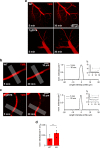Local perfusion of capillaries reveals disrupted beta-amyloid homeostasis at the blood-brain barrier in Tg2576 murine Alzheimer's model
- PMID: 37993886
- PMCID: PMC10666337
- DOI: 10.1186/s12987-023-00492-7
Local perfusion of capillaries reveals disrupted beta-amyloid homeostasis at the blood-brain barrier in Tg2576 murine Alzheimer's model
Abstract
Background: Parenchymal accumulation of beta-amyloid (Aβ) characterizes Alzheimer's disease (AD). Aβ homeostasis is maintained by two ATP-binding cassette (ABC) transporters (ABCC1 and ABCB1) mediating efflux, and the receptor for advanced glycation end products (RAGE) mediating influx across the blood-brain barrier (BBB). Altered transporter levels and disruption of tight junctions (TJ) were linked to AD. However, Aβ transport and the activity of ABCC1, ABCB1 and RAGE as well as the functionality of TJ in AD are unclear.
Methods: ISMICAP, a BBB model involving microperfusion of capillaries, was used to assess BBB properties in acute cortical brain slices from Tg2576 mice compared to wild-type (WT) controls using two-photon microscopy. TJ integrity was tested by vascularly perfusing biocytin-tetramethylrhodamine (TMR) and quantifying its extravascular diffusion as well as the diffusion of FM1-43 from luminal to abluminal membranes of endothelial cells (ECs). To assess ABCC1 and ABCB1 activity, calcein-AM was perfused, which is converted to fluorescent calcein in ECs and gets actively extruded by both transporters. To probe which transporter is involved, probenecid or Elacridar were applied, individually or combined, to block ABCC1 and ABCB1, respectively. To assess RAGE activity, the binding of 5-FAM-tagged Aβ by ECs was quantified with or without applying FPS-ZM1, a RAGE antagonist.
Results: In Tg2576 mouse brain, extravascular TMR was 1.8-fold that in WT mice, indicating increased paracellular leakage. FM1-43 staining of abluminal membranes in Tg2576 capillaries was 1.7-fold that in WT mice, indicating reduced TJ integrity in AD. While calcein was undetectable in WT mice, its accumulation was significant in Tg2576 mice, suggesting lower calcein extrusion in AD. Incubation with probenecid or Elacridar in WT mice resulted in a marked calcein accumulation, yet probenecid alone had no effect in Tg2576 mice, implying the absence of probenecid-sensitive ABC transporters. In WT mice, Aβ accumulated along the luminal membranes, which was undetectable after applying FPS-ZM1. In contrast, marginal Aβ fluorescence was observed in Tg2576 vessels, and FPS-ZM1 was without effect, suggesting reduced RAGE binding activity.
Conclusions: Disrupted TJ integrity, reduced ABCC1 functionality and decreased RAGE binding were identified as BBB alterations in Tg2576 mice, with the latter finding challenging the current concepts. Our results suggest to manage AD by including modulation of TJ proteins and Aβ-RAGE binding.
Keywords: ABC transporter; Alzheimer’s Disease; Blood-brain barrier; RAGE; Tight junctions.
© 2023. The Author(s).
Conflict of interest statement
The authors declare no competing interests.
Figures





Similar articles
-
Age-Dependent Regulation of the Blood-Brain Barrier Influx/Efflux Equilibrium of Amyloid-β Peptide in a Mouse Model of Alzheimer's Disease (3xTg-AD).J Alzheimers Dis. 2016;49(2):287-300. doi: 10.3233/JAD-150350. J Alzheimers Dis. 2016. PMID: 26484906
-
Impaired Amyloid Beta Clearance and Brain Microvascular Dysfunction are Present in the Tg-SwDI Mouse Model of Alzheimer's Disease.Neuroscience. 2020 Aug 1;440:48-55. doi: 10.1016/j.neuroscience.2020.05.024. Epub 2020 May 23. Neuroscience. 2020. PMID: 32450297
-
Aβ₁₋₄₂-RAGE interaction disrupts tight junctions of the blood-brain barrier via Ca²⁺-calcineurin signaling.J Neurosci. 2012 Jun 27;32(26):8845-54. doi: 10.1523/JNEUROSCI.6102-11.2012. J Neurosci. 2012. PMID: 22745485 Free PMC article.
-
The potential mechanisms of Aβ-receptor for advanced glycation end-products interaction disrupting tight junctions of the blood-brain barrier in Alzheimer's disease.Int J Neurosci. 2014 Feb;124(2):75-81. doi: 10.3109/00207454.2013.825258. Epub 2013 Aug 15. Int J Neurosci. 2014. PMID: 23855502 Review.
-
Role of the blood-brain barrier in the pathogenesis of Alzheimer's disease.Curr Alzheimer Res. 2007 Apr;4(2):191-7. doi: 10.2174/156720507780362245. Curr Alzheimer Res. 2007. PMID: 17430246 Review.
Cited by
-
Xixin Decoction's novel mechanism for alleviating Alzheimer's disease cognitive dysfunction by modulating amyloid-β transport across the blood-brain barrier to reduce neuroinflammation.Front Pharmacol. 2025 Jan 6;15:1508726. doi: 10.3389/fphar.2024.1508726. eCollection 2024. Front Pharmacol. 2025. PMID: 39834810 Free PMC article.
-
Targeting the RAGE-RIPK1 binding site attenuates diabetes-associated cognitive deficits.J Neuroinflammation. 2025 Jun 21;22(1):162. doi: 10.1186/s12974-025-03489-1. J Neuroinflammation. 2025. PMID: 40544260 Free PMC article.
-
Revisiting cerebral endothelial cells in Alzheimer's disease.Neural Regen Res. 2025 Oct 1;20(10):2911-2912. doi: 10.4103/NRR.NRR-D-24-00640. Epub 2024 Sep 24. Neural Regen Res. 2025. PMID: 39610099 Free PMC article. No abstract available.
References
MeSH terms
Substances
LinkOut - more resources
Full Text Sources
Medical
Miscellaneous

